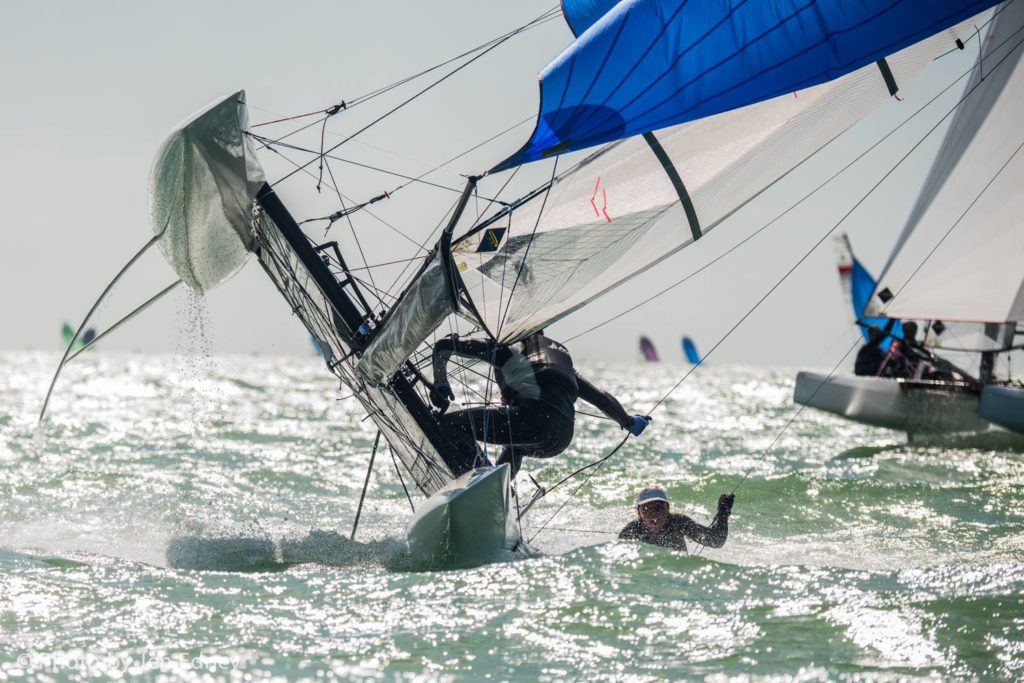
update: this story was updated to reflect that Darren Leong is a corresponding author of the study made by ISAF in 2014, not the lead author.
On a Nacra 17, the otherwise simple act of tacking puts immense strain on today’s Olympic hopeful. First, the crew comes off the wire and bends at the knees and hips into a squat, simultaneously stepping quickly, balancing on the mesh while stretching to grab the now-windward hull, pulling his or her body the rest of the way up, and rotating back into position. “They have to balance, they have to move in a way they’ve never had to move before,” says professional trainer Chris Herrera. “It’s a recipe for disaster in the lower body.”
Nacra, 49er and 49erFX sailors are the most injury-prone of the Olympic classes, with back and shoulder injuries most common in the 49er, and traumatic injuries from capsizing and impact with rigging most common in the FX and Nacra. “Foot-strap injuries, like broken foot bones and torn ligaments in the ankles, are common,” says 49erFX sailor Helena Scutt. “Concussions are also a serious concern as we work to keep these boats under control. Other boats only have to worry about the boom. We can swing around during a pitch pole and hit the gunwale.”
At the Sailing World Cup in Santander, Spain, in 2014, ISAF surveyed athletes in an effort to better understand the challenges of the newest classes. “We found that injuries occur more often in the newer Olympic sailing classes than in the older sailing classes,” says Darren Leong, the corresponding author on the study, initiated and funded by World Sailing. “There was a significantly higher injury prevalence seen in the 49erFX and 49er, which also reported the highest volume of acute injuries sustained in competition.”
The combination of new boats and high speeds creates opportunity for injury, says Herrera. “If sailors want to continue sailing these boats, they need to be able to handle them. It’s terrible to say, but the teams that survive the quad are the ones that will go to the Olympics.” In January, Herrera’s clinic in Miami was treating at least seven athletes from these classes. “If they don’t get better soon, they can’t sail their qualifying events and go to Rio,” he says.
Danish 49erFX sailors Ida Nielsen and Marie Olsen had their share of injuries this quad. In 2014, Nielsen sprained her ankle so severely that the team couldn’t sail for two months. Less than a year later, Olsen sailed the 49erFX World Championship with an elbow brace because of a twisting injury she sustained during the pre-worlds. “The worst thing you can imagine is not the pain of hurting yourself,” says Nielsen. “It’s fear of not being able to train for months or not being able to go to the Olympics. When we sail, we try not to think about it. We just do whatever it takes to get over the line first.”
As sailors gain more experience, Herrera expects a decrease in the number of injuries coming through his clinic, and therefore athletes will be able to compete in more than one quad. Trainers and coaches, he says, will also know which chronic injuries to look for, and will be able to start prevention and rehabilitation sooner.
Scutt, 23 , has been plagued with carpal tunnel syndrome in her wrists. It was a diagnosis missed by her doctors because they never expected it in someone so young. “It started five years ago, at the 29er Worlds,” says Scutt. “It was basically triggered by skiff sailing because of the load on the sheets.” When steroid injections failed to ward off numbness that set in during races and extreme pain afterward, USOC doctors urged her to take six weeks off for surgery. “If it had been realized earlier on what was happening, I would have started scapular strengthening and physical therapy earlier, and it might have been less of a problem,” she says. Since surgery, Scutt has focused on strengthening her back and shoulders to take the strain off her wrists and arms.
This is only her and skipper Paris Henken’s first quad, but Scutt has a cautious outlook. “I wanted to do three quads, but if I’m not up for it, then that’s how it is,” she says. “I think if I sailed a Laser or 470 that my injury wouldn’t have been a problem. In the FX, I’m always trimming a loaded sail, and that’s a perfect storm for this injury.”









